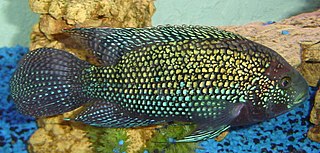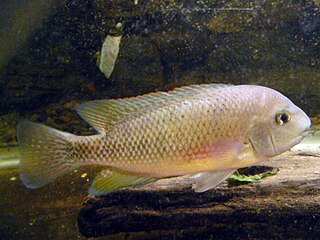
Cichlasoma is a genus of freshwater fish in the cichlid family. The genus was previously very large, including cichlids from North America, including Central America, and South America.

Crenicichla is a genus of cichlids native to South America commonly known as the pike cichlids. They are found in most tropical and subtropical freshwater habitats between the Andes and the Atlantic.
Paraneetroplus is a genus of cichlid fish native to moderately to fast-flowing waters in the Coatzacoalcos, Grijalva and Papaloapan river basins in southern Mexico. They reach up to 20–25.5 cm (8–10 in) in length.
Theraps is a genus of cichlid fish that includes only a single species, the Arroya ciclid from fast-flowing rivers and streams in the Usumacinta and Polochic basins of southern Mexico and Guatemala. It is a medium-sized cichlid, up to 19 cm (7.5 in) in standard length.

Thorichthys is a genus of cichlid fish that is native to the Atlantic slope of Middle America, ranging from southern Veracruz and the Yucatán Peninsula in Mexico, to Guatemala and Honduras, with introduced populations in a few other countries. They tend to inhabit moderately-flowing to standing water such as rivers, streams, lakes, ditches and lagoons, and they are primarily freshwater fish, although T. helleri and T. meeki may occur in slightly brackish habitats.

Vieja is a genus of cichlid fish from Central America and Mexico. The majority of the species are freshwater fish found in stagnant or slow-moving waters of southern Mexico to El Salvador, but V. maculicauda, which also occurs in brackish waters, ranges south to Panama. They are high-bodied cichlids that reach lengths of up to 17–35 cm (7–14 in) depending on the exact species. Vieja feed mostly on vegetable matter, but may also take small invertebrates.

Archocentrus is a genus of cichlid fish from Central America. It currently contains a single species, the flier cichlid, which is found in stagnant and slow-moving freshwater habitats such as lakes, ponds, ditches, swamps and rivers in Honduras, Nicaragua and Costa Rica. It is up to 11 cm (4.3 in) long and feeds on invertebrates and detritus.

Herichthys is a genus of cichlid fishes native to North and Central America. Most are endemic to Mexico, but H. cyanoguttatus is also found in southern Texas, and has been introduced to central Texas and Florida.

The Salvin's cichlid, also known as the yellow-belly cichlid or tricolored cichlid, is a species of the family Cichlidae. It is found in rivers of the Atlantic slope of southern Mexico, Belize, and Guatemala.

The Cichlasomatinae are a subfamily of cichlid fishes, including all cichlids native to the Greater Antilles, United States, Mexico and Central America, and many of the cichlids from South America. The subfamily Cichlasomatinae is often divided into two tribes: Cichlasomatini and Heroini, however some authorities classify these two tribes as part of the wider Neotropical and marginally Nearctic subfamily Cichlinae.
The Cichlid Room Companion (CRC) is a membership-based webpage dedicated to the fishes of the Cichlid family (Cichlidae). The site was launched in May 1996 and offers arguably the most comprehensive authoritative catalogue of cichlids on the web, which is illustrated with more than 25,000 photographs of fishes and 2,000 of habitats, as well as over 300 videos of cichlids and their habitats. It also “offers access to ample information about 253 genera and 2371 species”, a discussion forum as well as many articles about taxonomy, natural history, fish-keeping, field accounts, conservation, and other cichlid related topics; mostly written by citizen scientists and people who specialize in cichlids. The species summaries provided in the form of profiles include taxonomic, distribution and habitat, distribution maps, conservation, natural history, captive maintenance, images, videos, collection records, and an extensive bibliography of the species included and have been prepared by world-class specialists. A document establishes the standards followed in the preparation and maintenance of the cichlid catalogue. The site is administered by its creator and editor, Juan Miguel Artigas-Azas, a naturalist, who is also an aquarist and a nature photographer. In 2008, the American Cichlid Association (ACA) awarded Artigas-Azas the Guy Jordan Retrospective Award, which is the maximum honor that association gives to people who have done extensive contribution to the international cichlid hobby.

Maskaheros is a genus of cichlids fish found on Atlantic slope of southern Mexico and Guatemala in the Coatzacoalcos and Usumacinta River drainages. They are relatively large, high-bodied cichlids and were formerly included in the genus Paraneetroplus or Vieja.
Kihnichthys ufermanni, the Usumacinta cichlid, is a species of cichlid found in a few rivers in the Usumacinta River basin in Guatemala and southern Mexico. It typically occurs in rivers that are about 10–50 m (33–164 ft) wide, fairly deep, have few or no aquatic plants, and a variable water current. This species is the only known member of its genus, but several of its features, including the chisel-like teeth, are shared with Cincelichthys and whether they should be merged into a single genus is not yet fully resolved; a review in 2020 recommended that the Usumacinta cichlid should be moved into Cincelichthys. The Usumacinta cichlid reaches a standard length of 25 cm (10 in).

Cincelichthys is a genus of high-bodied cichlids found in southern Mexico to Guatemala, where they inhabit lakes, rivers and other freshwater habitats. They are large cichlids, up to 35–42.5 cm (14–17 in) long depending on species, with females reaching smaller sizes than males.
The Montecristo cichlid is a species of freshwater fish from the Atlantic slope of southern Mexico and Guatemala. This cichlid occurs in lagoons, creeks and rivers with slight to moderate current in the Grijalva–Usumacinta, Candelaria, Champotón and Coatzacoalcos river drainages. It is currently recognized as the only species in its genus, but it is closely related to –and possibly should be merged into– Vieja. The Montecristo cichlid reaches up to 24 cm (9.4 in) in standard length.
Chiapaheros grammodes is a species of cichlid fish found in the upper part of the Grijalva River basin in southern Mexico and far western Guatemala. Adults generally inhabit areas with moderate to strong current, but they can also be found in backwaters and juveniles generally occur in calm waters. This species is the only known member of its genus, but historically it has been placed in several other genera. It reaches up to about 20 cm (8 in) in standard length. C. grammodes is relatively aggressive and quite predatory, tending towards piscivory. Both natural and aquarium hybrids have occurred between this species and Vieja hartwegi.

Talamancaheros is a genus of cichlid fish found in fast- and moderately-flowing rivers on the Pacific slope of the Talamanca mountains of Costa Rica and western Panama. Talamancaheros reaches up to 25 cm (10 in) in standard length.

Cichlastomatini is a tribe of cichlids from South America, one of two tribes that make up the subfamily Cichlasomatinae. They were recognised in 1983 as an assemblage by the Swedish ichthyologist Sven O. Kullander by their four rather than five 5 dentary foramina in the lateralis canal system of the head, describing them as closely related to the genus Cichlasoma. Melanie Stiassny suggested that these fishes recognised as a clade by Kullander were divided into two groupings in 1991 which she termed cichlasomines and heroines, Kullander formally raised these to the tribes Cichlasomatini and Heroini of the subfamily Cichlasomatinae in 1999. In other classifications the tribe Cichlasomatini is placed in the subfamily Cichlinae.

Geophagini is a tribe of cichlids from the subfamily Cichlinae, the American cichlids. It is the sister taxon to the clade which includes the Cichlasomatini and Heroini. Fishes in the Geophagini are distributed from Panama south to Argentina, it is the most speciose of the seven tribes within the Cichlinae and it is subdivided into three sub-tribes, Acarichthyina, Crenicaratina, and Geophagina which together contain over 200 species. Geophagines show morphological and behavioural specialisations to enable them to sift the substrates within their mouths so that they can separate benthic invertebrates from substrates dominated by sand or silt.

Chuco is a genus of medium-sized cichlid fishes from moderately to fast-flowing rivers and streams on the Atlantic slope of southern Mexico and northern Central America.













